In September of 2019, a few days after our long-awaited Model 3 arrived on top of a tilt tray truck in our driveway, we took the pristine Tesla on a 360 km family road trip from Perth to Hyden.

Although we had been a two PHEV family since April of 2016, this was the first time we owned an electric-only vehicle, also known as a BEV (Battery Electric Vehicle) or PEV (Pure Electric Vehicle). With no internal combustion engine generator to rely on anymore, we had our first experience of ‘range anxiety’ when the car began warning me to plan my next charge because “all known charging locations will be out of range soon.”

Not long after the car began prompting me to “stay below 105 km/h to reach destination”. Being a new car, I was not only keen to test it out and to see what would happen if I ignored the warning but I was also curious about this ‘range anxiety’ phenomena that was often cited in EV articles and YouTube videos at the time. I kept Autopilot set to 110 km/h and not long after the warning changed to prompting me to stay below 100 km/h and then to below 95 km/h.

When the projection chart showed we’d get to Hyden with just 2%, much to my wife’s and I think the kids’ relief, I lost my nerve and I put the car into Chill Mode and slowed right down to 90 km/h.

We ended up getting to Hyden with 4% or 20 km of range and immediately after arriving I plugged the car into a 10A socket at the Hyden Tennis Club.
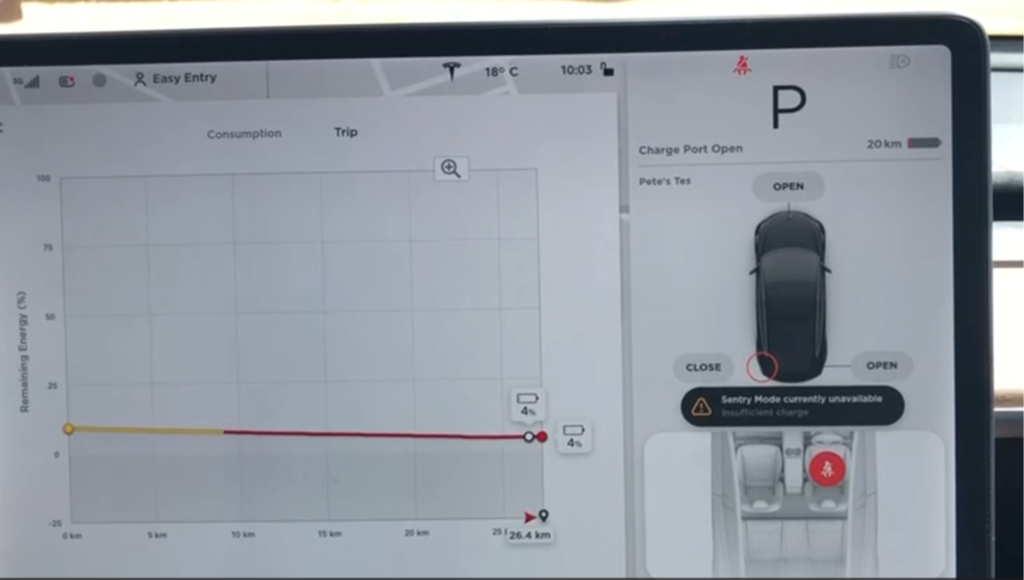
I didn’t have much luck with getting access to the 3-phase 32A socket at the closed Visitor Centre and I couldn’t get through on the phone either, but I managed to find a 15A socket in the shed on our friend’s property where we were staying. As I was keen to show off the car and took our hosts along for a test drive, when it came time to go back home, we couldn’t leave until after 2 PM as we had to wait for the car to finish trickle charging on the 15A socket in the shed. Being a Performance (Stealth) Model 3, with roughly 73.5kWh of usable battery capacity, it takes approximately 30 hours to charge from 0-100% on a 10A socket and about 20 hours using a 15A plug.
What a difference one proper DC charger makes
Fast forward to December 2023 and Hyden has just become the 26th location to be commissioned on the WA EV Network. It means that we’re now in the back half of the rollout because when complete in early to mid next year, the network will consist of 49 much-needed EV charging locations averaging approximately 200 km apart all the way along the coast from the Northern Territory border to the South Australian border and also to Kalgoorlie.
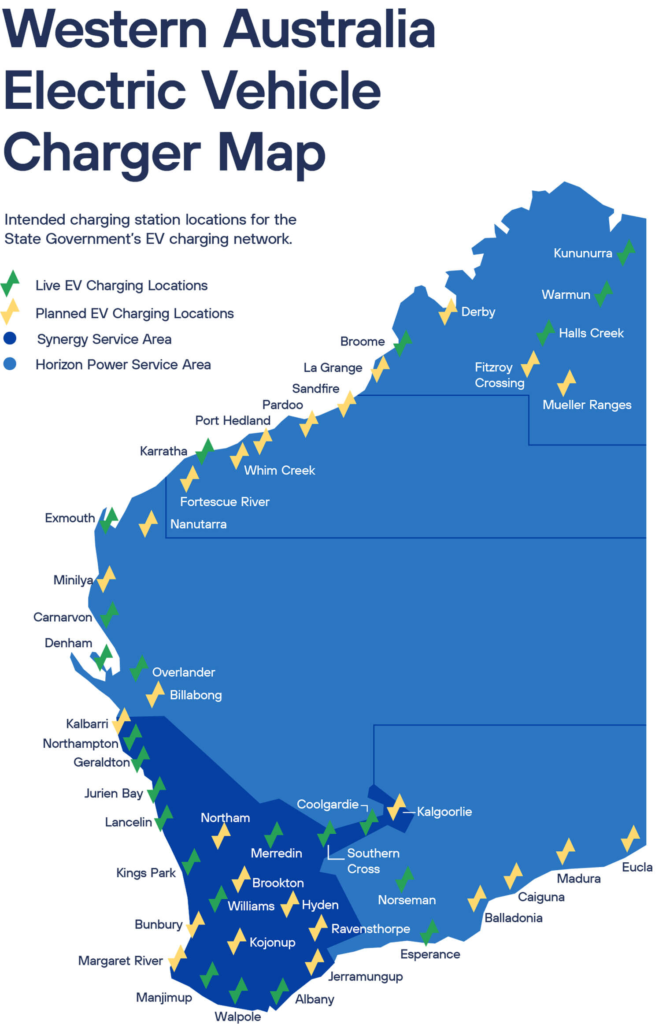
With the WA EV Network marking it’s halfway milestone, I couldn’t resist taking the same car, this time four years older and with over 110,000km on the odometer, on the same Perth to Hyden road trip. Perhaps still traumatised from the last experience, my wife and the kids were more than happy to leave me to my own devices so I set out on my own this time and about four hours later I arrived in Hyden with 9% and plugged into the freshly commissioned Hyden 150kW Kempower unit (I was aiming for 10%). Only half an hour later I had gained about 300 km of range which would have been enough to allow me to head back with a top-up at Williams but I got chatting and before I knew it, another 20 minutes went past and the car was already charged to 100%. (Once the Brookton charger is commissioned next year, a 20 to 30 minute charge in Hyden will be enough to get to Brookton for a quick top up on the way to Perth.)
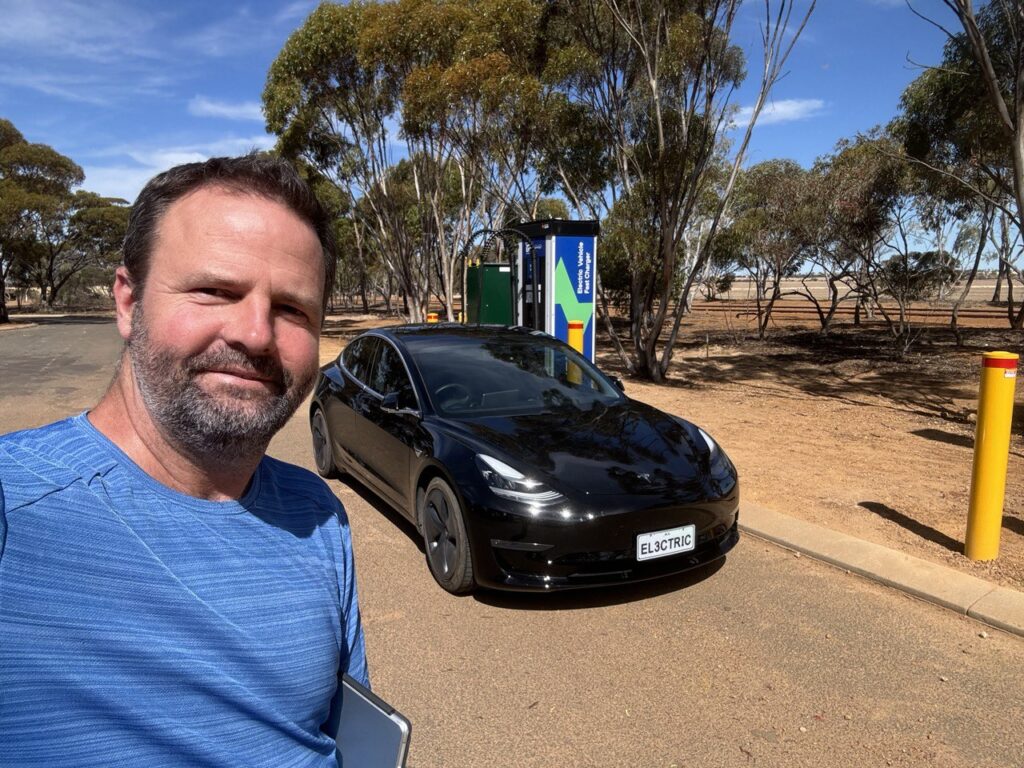
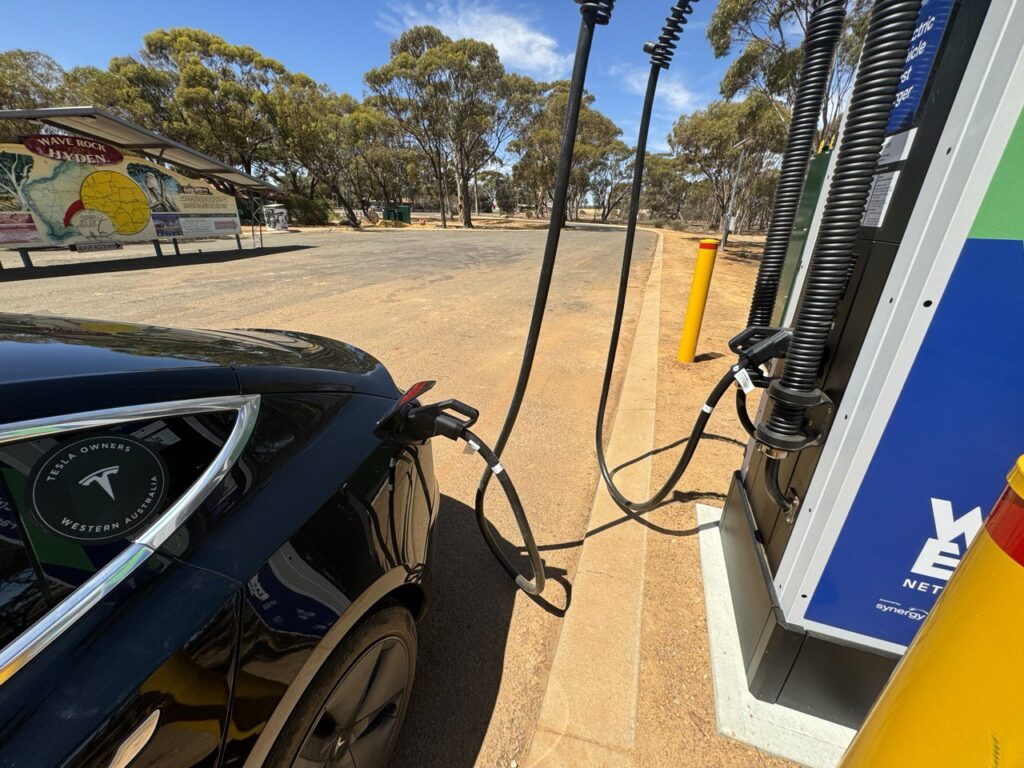
Four years earlier, we had no choice but to trickle charge for 20 to 30 hours, which is a little like pouring petrol through a clogged-up straw. Comparing the two experiences is night and day, it is like comparing a rabbit to a tortoise. In other words, it’s just not comparable. Think about it this way, compare going to the beach for 20 to 30 minutes versus 20 to 30 hours or going to the shops for 20 to 30 minutes compared to 20 to 30 hours or popping into work for 20 to 30 minutes as opposed to a marathon 20 to 30 hour shift. Doesn’t matter how you look at it, the two time frames aren’t even in the same ball park.
In case you’re wondering, even though Tesla may be starting to roll out 1 megawatt (1,000kW) V4 Superchargers or Megachargers to service its Semis, the power of most DC (direct current) chargers these days will range between approximately 50kW and 350kW, putting the 150kW Kempower unit a little below the middle of that pack. Although some of the newest EV models, such as the recently delivered Cybertrucks are capable of charging at 350kW it doesn’t mean that a 350kW charger would be more than twice as fast as a 150kW unit. The limiting factor is the current generation of EVs, which in Tesla’s case, top out anywhere between approximately 190kW and about 250kW, depending on the model and its corresponding battery chemistry.
For those who think that a 20-to-40-minute time period to recharge a car is still too long, I’d like to point out something that I discovered on my 17-day trip around Australia in the Model Y RWD, the slowest and shortest-range car that Tesla makes. While I was charging at the various roadhouses, as suggested by TOCWA (The Tesla Owners Club of Western Australia) Chairman Rob Dean, I began to observe other people refuelling their ICE cars. I can tell you that the notion that people refuel their ICE car in 5 to 7 minutes on a long road trip is a fallacy. Granted, while it is possible, it happens very rarely and while most people may stand by their car with their hand on the bowser nozzle for six or so minutes, they will very rarely hop straight back behind the wheel to drive for another four hours. Instead, they will repark the car and they’ll use the restrooms, grab something to eat or drink and stretch their legs for a while. It means that an average roadhouse stop takes 20 to 30 minutes which is about as long as a Tesla Supercharger takes to recharge a Tesla. In fact, when my brother and I together with both families drove two Teslas along the 900 km route between Melbourne and Sydney earlier this year, we only needed to stop twice and both times our cars were charged to 100% before our food even came out. (By the way, as illustrated in this article, the last 20% of an EVs range takes the longest to charge and is often unnecessary.)
As an aside, for those reading this article who don’t yet own an EV or for the single EV families who are thinking about replacing their second car, it may be worthwhile to note that we no longer manufacture the Falcons and Commodores in Australia and hence we have no choice but to buy what the rest of the world sells and whether by legislation or market forces, the whole world is going electric. It, therefore, won’t be long before there won’t be much of a choice. That said, with ICE cars representing old technology what do you think a second-hand ICE car will be worth in 5 or 10 year’s time? Probably as much as a Walkman or DVD player is worth today. It’s old technology and when the world moves on, the old technology that’s left behind always plummets in value.
Getting back to the WA EV Network, yes, we all wish the WA State government made available a larger sum of money so that, similar to NSW, we could have had a network with an average uptime of 99.95% with ‘chargers that just work’. In case you’re wondering, yes, you guessed it, I am talking about none other than the Tesla Superchargers.

That said, I think I echo the sentiment of most of the WA EV community, when I say that we are very thankful for this much needed and critical public infrastructure. Although, as mentioned, we would all have preferred a slightly larger sum of money but we are nevertheless not only thankful for the $21.6 million but we’re thankful for Synergy and Horizon Power listening to TOCWA (The Tesla Owners Club of Western Australia) and the wider EV community when it came to the design of the network. As a result, it means we have a fantastic network which is fit for purpose.
By exclusively utilising only the Combined Charging System standard using only CCS2 cables and Type 2 charging points instead of the discontinued and obsolete CHAdeMO connectors, we’ll have a network that is built for the present and the future instead of the past. It means we have reliable and much faster 150kW Kempower chargers on the grid-tied portion of the network rather than the 50kW alternative. It means that with AC backup chargers every location can charge a minimum of three EVs at a time. It means we have idle fees to stop EV drivers treating the EV charging bays as EV parking bays, we have a credit card payment solution, we have a resilient system than can operate in emergency situations when the mobile network goes down, we have some but admittedly not enough drive-through locations allowing for EVs towing trailers, caravans or horse floats to charge without unhitching. We have a great network.
We have a world class network second only to Tesla’s Supercharger network and once completed, the state government will have provided most of the backbone of this critical public infrastructure for the private sector to backfill, but there is one glaring omission and that’s the inland Perth to Port Hedland route along the Great Northern Highway.

As TOCWA Secretary Harald Murphy has identified, it doesn’t make sense to have a road network that only services some towns and not others it doesn’t make sense to have an EV highway that leaves out major towns and regional centres. It’s a matter of equity, it’s a matter of access, it’s about tourism and it’s just not right to ignore and forget about places like Mount Magnet, Meekatharra or Newman to name just a few. With the WA EV Network having reached its halfway point yesterday, and with the retirement of Bill Johnston, (who said “I’m not saying no” to the proposed addition), the incoming State Energy Minister Reece Whitby has an ideal opportunity to announce the extension to the network.
It should be noted that the blueprints for the WA EV Network came from University of Western Australia Professor Thomas Braunl’s 2018 report which proposed three options for the network. All three options, included the Perth to Port Hedland route along the Great Northern Highway and the projected cost was estimated at $18.9 million, $23.6 million and $28.9 million for the Minimal, Proposed and Extended options respectively. (These were 2018 figures, therefore, if adjusted for WA inflation (All Groups) these numbers would be approximately 20% higher at $22.4M, $27.98M and $34.27M.) For reference the WA State Government has invested $21.6M into the WA EV Network.
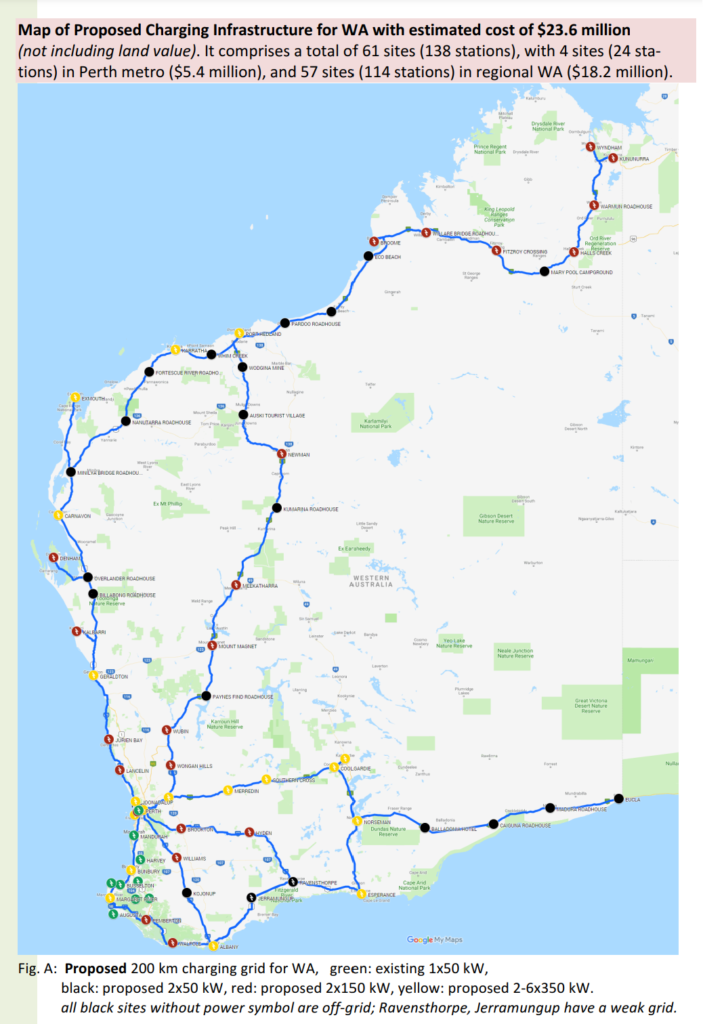
The inland route from Perth to Port Hedland will cost less than $5 million and it needs to be announced now while we have the processes and the human and other resources in place rather than starting again from scratch in one or two years’ time. (To put the $5 million figure into perspective, just one freeway onramp costs about $20 million. To put it another way, there are 137 local governments or councils in Western Australia and some of them spend $20 million on just landscaping in one year alone, whereas the WA EV Network is critical public infrastructure that will benefit hopefully all Western Australians for not just one year but for 5, 10 or many more years into the future.)
Please join TOCWA, AEVA and the wider EV community in calling on Minister Whitby and the WA State Government to finish what they started and to complete the WA EV Network thereby making EVs accessible to all Western Australians, irrespective of where they live.
The minister can be contacted on the following links:
https://www.wa.gov.au/government/premier-and-cabinet-ministers/reece-whitby
https://www.reecewhitby.com.au/
https://www.facebook.com/ReeceWhitbyMLA/
Please note, this article was edited on 21 December 2023. The changes consisted of the inclusion of the paragraph quoting Professor Thomas Braunl and the accompanying map, which were inadvertently left out of the original version.

Pete Petrovsky is an active TOCWA (Tesla Owners Club of Western Australia) committee member and a long-time EV enthusiast. He placed a $6,000 deposit for a Model X (#39) in 2014 but when it came to taking delivery he couldn’t justify the cost, so instead, he and his wife decided to buy two PHEVs and wait for the Model 3. In March of 2016 they bought the Holden Volt and a couple of weeks later the Mitsubishi Outlander PHEV, and on the day it was unveiled, Pete ordered the Model 3. After selling the Outlander, in September 2019, Pete received his long awaited first Tesla, a Model 3 Performance. Despite still loving their Volt, Pete and his wife took delivery of their second Model 3 in December 2021 and a year later a Model Y RWD which two days later Pete drove around Australia in 17 days. In his spare time, Pete also runs the ‘Tesla Ahead of the Curve’ YouTube channel and is also a long-term Tesla shareholder. Pete can be reached on X @Ahead_of_Curve
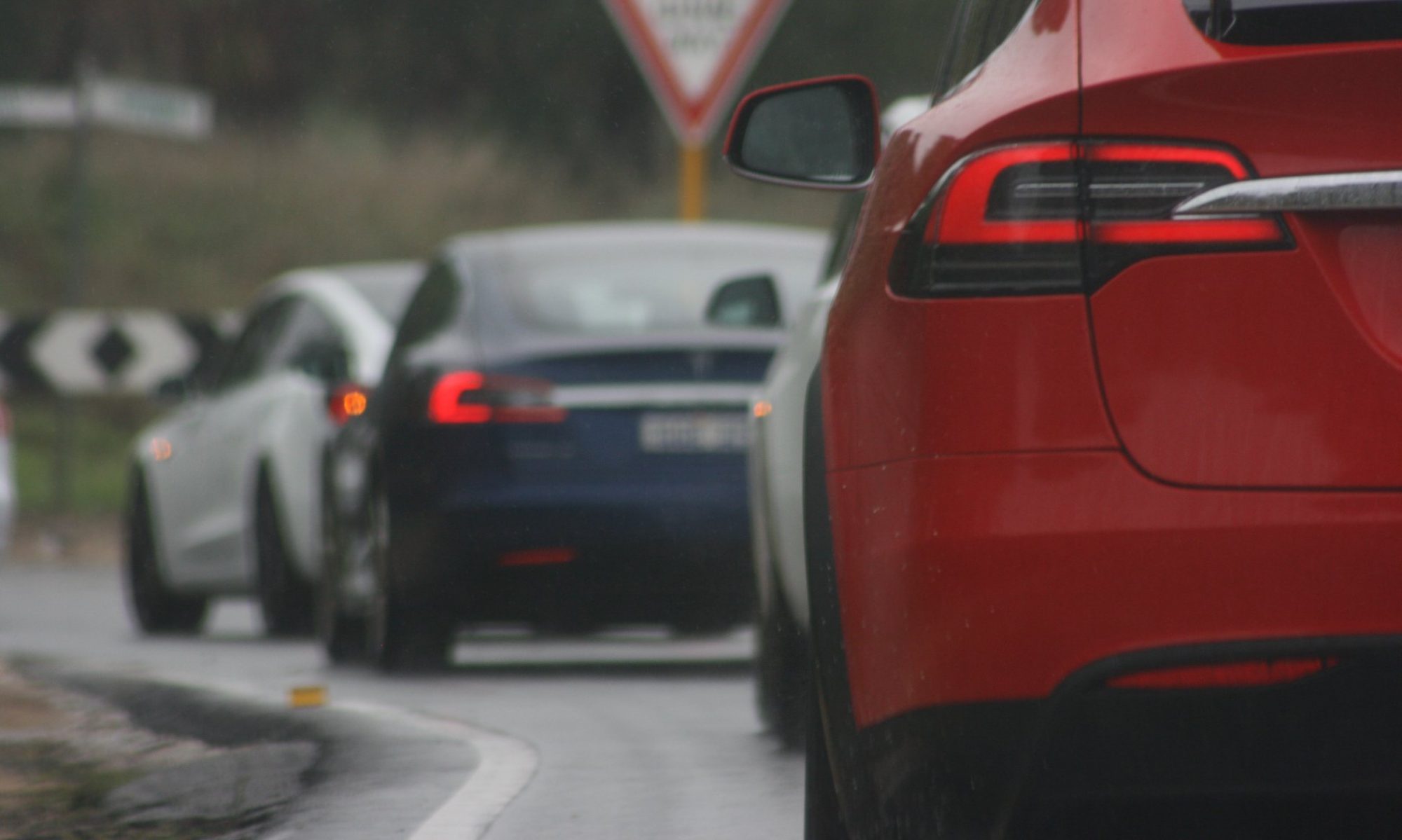
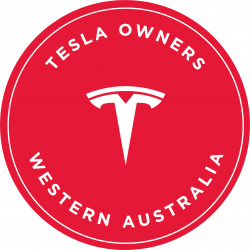
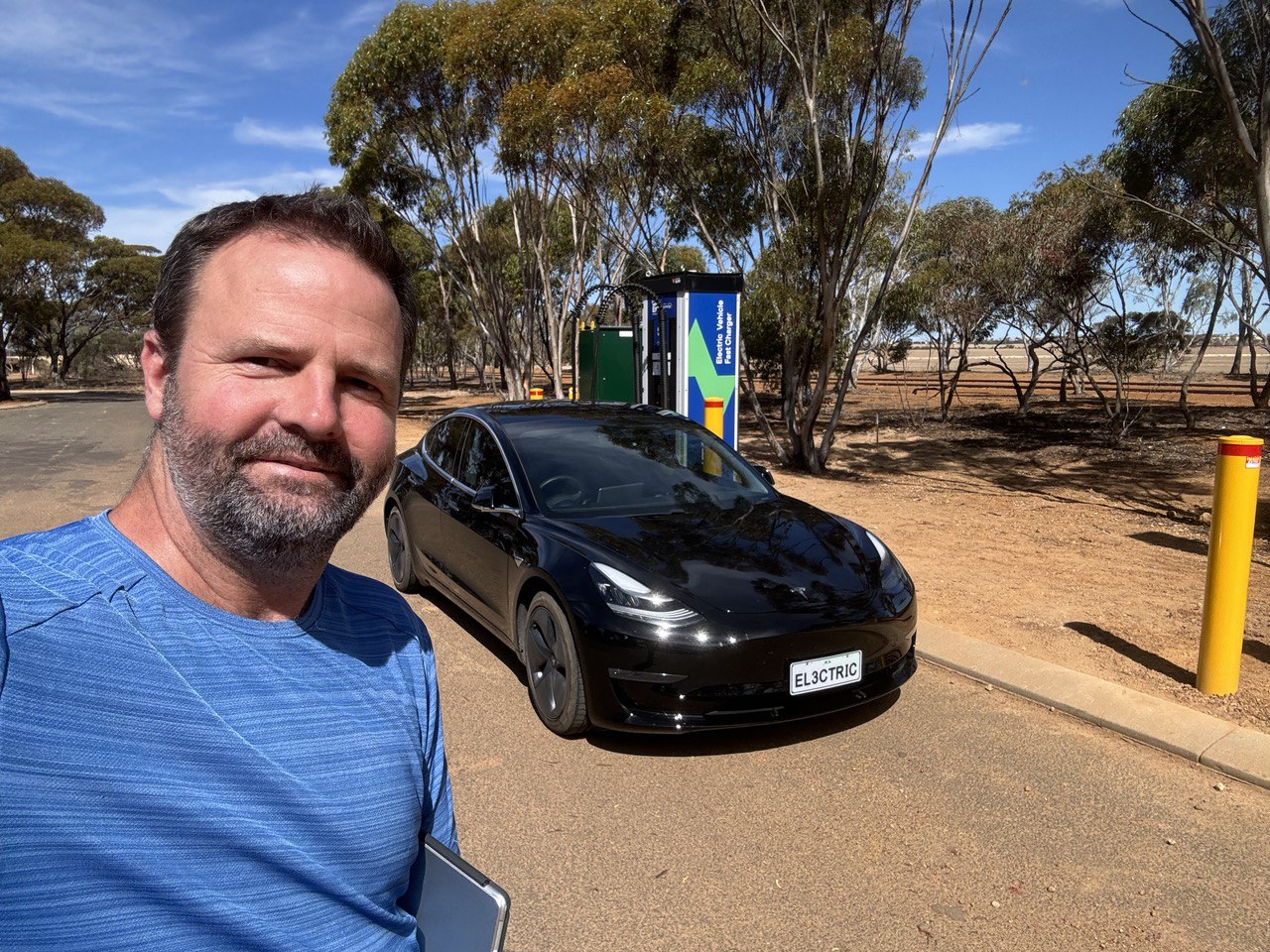
There will always be the “Why didn’t they put one here?” comments and I do get that they couldn’t do everything for everyone, but if the WA government is serious about getting people into EVs, then they should treat this as “Round One” of an ongoing program, and follow up with further rounds to fill the obvious gaps.
One that comes to mind for me is the Brand Highway. There are no fast chargers on the entire length of the Brand Highway, yet there are two on the Indian Ocean Drive (Lancelin and Jurien Bay.) Very few people who travel between places north of Dongara and Perth use the Indian Ocean Drive. The Brand Highway is the route of choice.
If the government won’t do it, surely it would be a lucrative proposition for private investors?
Where on Brand Highway would work, do you think? – it’s a pretty regular route for many, and they just choose to go via Jurien at the moment – it’s not much slower – and less trucks 🙂
Badgingarra would be the logical choice, but it really depends on the existing electricity infrastructure. Anywhere that requires a costly upgrade will be ruled out in a heartbeat. Next best option would probably be near Warradargee (Halfway Mill Roadhouse).
I completely agree with your sentiments Russel. I would add that the role of government is to step into the market in situations like these where, at least for the time being, there is little if any economic incentive for the private sector. Apart from the early adopters, most people won’t buy an EV if they can’t drive it everywhere they can drive an ICE car. If expanded, the WA EV Network will change that and with more EVs on the road it will bring in private investment which can backfill the backbone. Interestingly, the 2018 report by UWA Professor Thomas Braunl, which served as a blueprint for the WA EV Network, proposed 3 options and all three included the Perth to Port Hedland route along the Great Northern Hwy.
Really looking forward for a charging station on Brand-highway. It’s a shame that there is not even a single charging station .
Yep – We’re now aware that the National rollout managed by NRMA will have chargers at Cataby and Eneabba, so Brand Hwy will be covered – not sure of the timeframe at this point
Yes the time frame is one thing but the problem with the NRMA network is that they are picking the lowest hanging fruit and rather than expanding the overall EV network they are mostly doubling up at existing locations. As they are using taxpayer dollars, Minister Chris Bowen should have made them to do the hard and hence lower economic return sites first. Several other frustrations with the NRMA network. Why are they planning on installing CHAdeMO? It’s 2023 (soon 2024) and CHAdeMO is an obsolete discontinued standard. We should be installing chargers for the present and the future, not the past. In the 1st half of 2023 only 2 out of the 44 EV models sold in Australia used CHAdeMO and they accounted for <0.65% of all EVs sold here. This % will soon fall to 0.1% and then 0.001%. Doesn't makes sense to devote 50% to <1%. EV drivers will be very frustrated when there is a line of EVs waiting to use the CCS2 while the CHAdeMO cables collect dust. 2. Also, I'll wait to see how many of the sites will have drive-through configurations so that EVs towing trailers, caravans, horse floats etc can also charge without having to first unhitch. We just got back from a holiday where we towed a trailer with our Model Y. It's just not practical or even safe to unhitch a trailer and then there is the issue of finding a parking spot for it. 3. I don't believe these chargers will have idle fees which means they will be used as EV parking stations instead of just EV charging stations. 4. Will the chargers automatically revert to free vend if the mobile network goes down? In an emergency like a fire, flood etc the first thing to go down is the mobile network and that's when the chargers are needed the most. 5. Will the NRMA chargers have the option to use a credit card to pay or will we be forced to use the app? What will happen if you can't get reception at the remote areas to connect to the app? 6. Will each NRMA charging station have the ability to charge a minimum of 3 cars at any one time? The WA EV Network has been designed to address all the above and more because Synergy and Horizon Power consulted with and listened to TOCWA (The Tesla Owners Club of Western Australia) and the wider EV community. It doesn't seem like NRMA, RAA or Chris Bowen did the same and I can already see the National EV Charging Network being worse for it.
Since publishing this article, I have had numerous enquiries about either setting up a petition or requests for a template to use to write to Minister Whitby. I’m not sure whether a petition is the best way to go at this stage, but I happened to run into a lovely gentleman and TOCWA member at the Tesla store earlier this week and he mentioned that after reading this article he wrote a letter to the Minister. He was also kind enough to share it with me and while he didn’t necessarily wish to advertise his name, he was happy to also kindly share his letter with others who may find it helpful. Please find it below:
Dear Minister Whitby,
I trust this letter finds you well. My name is XXXXX, and I am writing to you as a proud electric vehicle (EV) owner and a resident of XXX Perth Suburb XXX. Since 2020, I have been driving an electric vehicle to contribute to reducing my carbon footprint. I wish to express my sincere appreciation for the commendable efforts the State Government has made in advancing the EV charging infrastructure in Western Australia.
The progress achieved so far has been impressive, and the efficiency of the work crews installing the charging stations has undeniably been a game-changer for EV drivers like myself. I am grateful for the state’s commitment to fostering sustainable transportation solutions. However, I am writing to bring to your attention a vital consideration for the further expansion of the EV charging network. The Dalwallinu to Newman inland highway is not yet covered by the charging infrastructure. As someone
who frequently travels along this route, I believe its inclusion in the charging network is crucial.
The economic benefits of extending the charging network along this inland highway are evident, especially given the expected increase in the number of EVs on the road in the next 2-5 years, including government fleet vehicles. Following the example set by the Northern Territory government fleet plans, it makes strategic and economic sense to address this now while the logistics,
such as work crews, are already in place for the current charger installations.
As a science teacher with over 20 years of experience, I spend my school holidays gold prospecting around Cue, Meekatharra, and Nullagine. The availability of EV chargers along the inland route would greatly enhance the feasibility of these trips for me and fellow EV owners.
I kindly urge you to consider commissioning the EV charging network to cover the Dalwallinu to Newman inland highway. This addition would essentially complete our state’s charging network and provide substantial benefits to EV drivers and the broader community. I am confident that such a decision would garner further support for the government, as it has consistently demonstrated its commitment to sustainable transportation solutions.
Thank you for your time and consideration of this matter. I appreciate the efforts of the State Government in promoting environmentally friendly practices and look forward to witnessing the continued growth of the EV infrastructure in Western Australia.
Sincerely,
Badgingarra would be the logical choice, but it really depends on the existing electricity infrastructure. Anywhere that requires a costly upgrade will be ruled out in a heartbeat. Next best option would probably be near Warradargee (Halfway Mill Roadhouse).
So long as government grants are given out to private operators for building fast chargers I would be inclined to have just three criteria regarding the location:-
1. Must be in a town or village that already has a petrol station that has operated for more than a decade. But the fast charger does not need to be at the petrol station or even associated with that business.
2. There must be no existing fast charger within 50km. Nor any proposed in such a location that have already been awarded a grant.
3. There must be at least one fast charger within 300km. Or a proposed one that has already been awarded a grant.
Repeat the process each year.
This would focus the government on expanding coverage. And leave the infill of more capacity entirely to the private sector.
Yeah – not certain I see a lot af value in any of these criteria 🙂